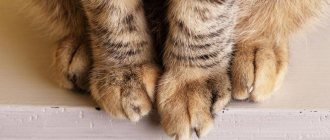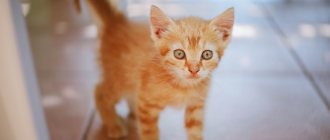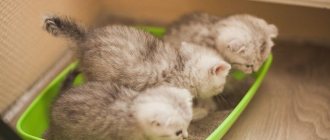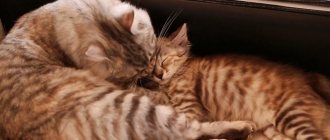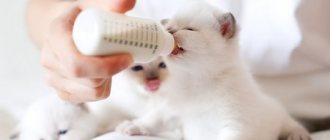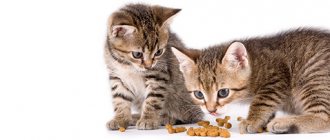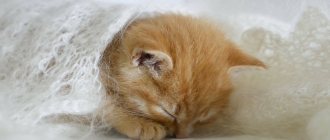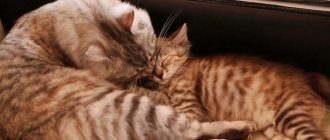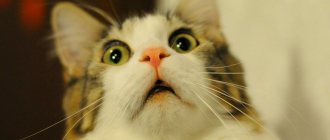If there is a new addition to your cat family, get ready for sleepless nights. And don’t even try to deceive yourself by the temporary helplessness of babies and their dependence on their mother.
Pretty soon, the fluffballs will stop crawling and confidently stand on all fours in search of adventure. At this point, you will have to answer for their safety. But knowing what time kittens begin to walk, you can protect them from possible problems, injuries and deviations.
From newborn to full member of feline society
Newborns weigh only 100 g. For the first 10 days they rely completely on their mother, as their senses are just beginning to develop.
Kittens are born blind, deaf and toothless. Their only reference point in space is their developed sense of smell. With its help, they can easily find mother's nipples located within 60 cm.
It takes a lot of time to develop into a full-fledged member of cat society. Each stage of growing up is unique and full of challenges, so try to give your pets all the support they need.
Eye opening
The eyes open 10-14 days after birth. The exact time depends on gender and coat length. Girls with short hair always mature earlier than boys with long hair.
Please note that all newborns have blue irises. With age, its color may change.
Teething
Milk teeth erupt on days 21-28, and after another 2 months their place is gradually taken by molars. By this point, the pets have already left the “nest”, and all poorly lying objects suffer from their new teeth.
Standing up and walking
Along with vision comes hearing. Thanks to new sensations, the world around us becomes more and more interesting.
Out of curiosity, kittens crawling on their tummy begin to make their first attempts to stand on their paws. At 3 weeks of life, they are already trying to walk, but they do it very clumsily and often fall. Their coordination improves by about 1 month.
First taste of adult food
Complementary foods are given at 1-1.5 months, when the cat’s breast milk supply begins to decrease. All food served is thoroughly boiled and crushed, achieving a liquid consistency. Solid foods are introduced into the diet only after all baby teeth have appeared.
When to give the baby to new owners?
Acquaintance with a new family should be done at 2.5-3 months. By this point, the diet of kittens is no longer different from that of an adult, so they cope much more easily with separation from their mother. This age is also optimal for vaccinations that provide immunity against the most common viruses.
New owners will have to go through 2 more stages with their mustachioed pets on the way to growing up: the first molt and puberty. After this, the active growth phase ends, and the animals are equated to adults.
When does a cat purr?
Although scientists don't fully understand how cats can make sounds that calm them like humans, we do know what situations cats purr in:
Indeed, they found that a cat typically begins to purr in the following situations:
- When he feels good, when he feels warm and comfortable, when he is stroked, when he cuddles up to you...
- When he wants to calm himself, calm down, relieve stress or calm his comrades;
- A cat may also purr to relieve pain or discomfort;
- To communicate with people.
How does a cat's locomotor system develop?
The musculoskeletal system consists of bones, muscles and joints. Only the hind legs are a direct continuation of the cat's skeleton. The forelimbs do not have a solid joint. They are connected to the skeleton by elastic and strong tendons. They provide smooth landings from great heights and a silent gait.
The hind legs are always stronger than the front legs, since they have to take a much larger load. They serve as support and help push off while running and jumping.
Full development of the body takes about a year, but motor function becomes available to babies already at 1 month of life. During this time they go through the following stages:
- Moving by crawling. In the first 5 days, pets move only in the direction of their mother to eat. By day 10, they begin to use their front legs. Pushing off the floor with them, the kittens ride more and more confidently on their bellies, like swimmers.
- Standing on your front paws. The first attempts are made in 1.5-2 weeks. By the end of this stage, the hind limbs also become stronger, expanding the available capabilities.
- First steps on 4 paws. When making their first movements, babies are guided by their mother. Repeating after her, they sway strongly and often fall out of the blue, but with each attempt they become closer to the goal.
- Gradual improvement of coordination to the level of adult animals. From the 3rd week, animals try to master not only walking, but also running and jumping. During the game, they can fight each other or hunt for their own tail.
The movements of whiskered pets at 1 month are very different from the timid attempts to learn to walk in the very first stages. By this age, small pets no longer fall over while running, actively play with each other and make confident jumps on low surfaces.
Do all kittens purr?
Sometimes kittens never purr. Indeed, if a kitten was abandoned by its mother, if it lost its mother very early, if it was separated too early, or if the kitten was weaned too early, it may never purr.
However, just because a kitten isn't purring doesn't mean the kitten is unhappy . The kitten may well find other ways to communicate its well-being and calm down. After all, a kitten can knead its legs or you can lick it so that you know that it feels good to be around you.
It's also possible that your kitten is purring but you can't hear it. Indeed, some kittens will purr so quietly that your ear will not hear the purr. However, if you gently place your hand on your kitten's throat, you will be able to feel the vibrations of his purring.
See my article: Why doesn't my cat purr?
When kittens start walking instead of crawling, what should you pay attention to?
The development of each animal is individual, so there is no need to rush things. Your main tasks are surveillance and security.
Small pets can start walking at completely different times. It all depends on the state of their body at the time of birth and the quality of nutrition.
If there are weakened kittens in the litter, help them find nipples or transfer them to artificial feeding. It is more difficult for such animals to compete with hungry brothers, so they often lag behind in development.
Track your cat's motor development at each stage. Pay special attention to week 3. If, when trying to stand on its legs, the baby squeaks loudly or limps heavily, take him to the vet.
The same should be done if you continue to crawl. Such symptoms may indicate congenital or acquired pathologies.
At what age does a cat purr?
As the kitten becomes an adult, the situation that causes the purring will change. The cat will purr in the presence of people. When the kitten stops nursing, that is, during the weaning period, the kitten will begin to purr in order to communicate with the man. This is his way of letting his owner know that everything is okay and that he likes to be hugged. However, even if purring is no longer reserved exclusively for the mother, it will always be a means of communication with calming intentions when the cat becomes an adult.
Possible problems and deviations
Treatment of the problem must begin immediately after its appearance. Otherwise, the pet may remain disabled.
Pain and weakness of the limbs are characteristic of the following pathologies:
- hip dysplasia, expressed in abnormal tissue development;
- liver diseases complicated by neurological disorders;
- acute intoxication;
- primary (arthritis) and secondary (trauma) dysfunctions of the musculoskeletal system;
- rickets, characterized by softening of the bones;
- malignant neoplasms.
The risk group includes Maine Coons. Due to active growth and large dimensions, 23% of representatives of this breed suffer from dysplasia. Their weight gain outpaces the development of joints, so the body simply cannot cope with the load placed on it. Also, this pathology can be inherited, and its presence must be recorded in the pedigree.
Please note that an animal suspected of being injured should not be transported. Shaking on the road can aggravate his condition, so it is better to call a doctor at home.
6–7 months: puberty
At 6–7 months, cats finish changing their teeth. The permanent incisors grow first, then the canines. The process of puberty is actively underway. Pets may become restless, some begin to mark their territory. During this period, hormonal levels change and animals may show aggression. If a pet tries to bite or scratch its owner, such attempts must be stopped.
The weight of a cat at 6–7 months reaches 2.4–.6 kg. Externally, the animals look like adult cats. They have developed hunting instincts, their movements become smooth and graceful. In the autumn-winter period, young cats undergo their first molt. Animals should be brushed regularly to prevent hairballs from forming in the stomach.
Causes of acquired deafness
The most common causes of acquired deafness are:
- Traumatic damage to the integrity of the eardrum. These are caused by falls from heights, blows, inept ear cleaning or acoustic trauma.
- Complications of infectious diseases. With advanced otitis media, the internal structures of the ear are involved in the inflammatory process, and the pet may become deaf. If the disease progresses and is complicated by purulent inflammation affecting the meninges, there will be a real threat to the animal’s life.
- Tumors of the ear structures or parts of the brain responsible for hearing function are the most difficult in terms of treatment and prognosis. Irreversible changes may occur.
- Ear parasites cause temporary hearing loss. Severe itching leads to severe scratching and injury to the outer ear structures. Competent and timely treatment can completely correct the situation.
- Ear plugs are a consequence of poor hygiene. Your cat's ears should be cleaned regularly to remove any wax that has accumulated there. Increased sulfur production is usually evidence of a malfunction of the excretory system.
- Age-related deafness in older cats is an inevitable symptom that is a sign of degenerative changes in the auditory nerve or structures of the inner ear.
Types of deafness by level of damage
- Conductive hearing loss is acquired. A pathological obstruction occurs in the path of sound transmission or amplification in the ear. This disorder can occur at the level of the outer ear (this includes malformations, cerumen plugs, otitis or neoplasms, ear parasites) or the middle ear (injuries and malformations of the eardrum, otitis media, otosclerosis). If the disease that caused the pathology is curable, then this type of deafness is reversible.
- Sensorineural deafness is often congenital. Most often, this is a pathology of the inner ear, which is a damage to the sensors - the hair cells of the inner ear. With their help, mechanical vibrations are converted into electrical impulses. This also includes pathologies of the auditory nerve. The perception of sound with this type of deafness is distorted or disappears completely. When the disease is acquired, its cause is often infectious diseases (meningitis, encephalitis), autoimmune diseases (Wegener's granulomatosis), as well as microcirculatory disorders in the inner ear, Mernier's disease.
- Central deafness occurs due to severe pathologies of the central nervous system and brain in cats. Its percentage in the total number of cases of deafness is small.
- Age-related deafness is a consequence of degenerative processes in the body of an animal on the verge of old age. The disease begins with the appearance of senile hearing loss in older individuals. It is slowly progressive and irreversible, and finally gives way to complete deafness.
